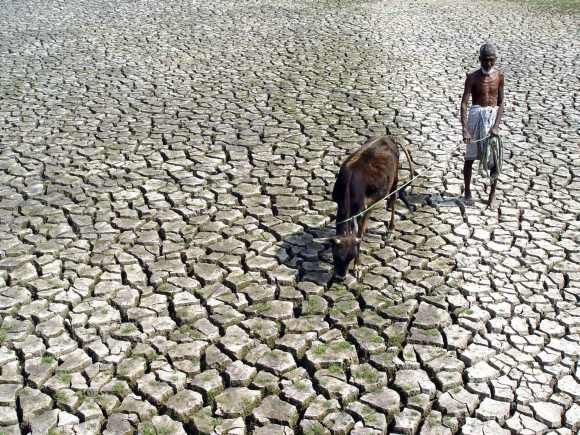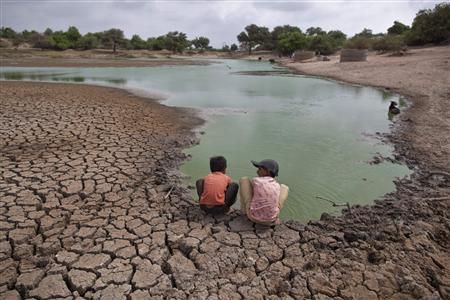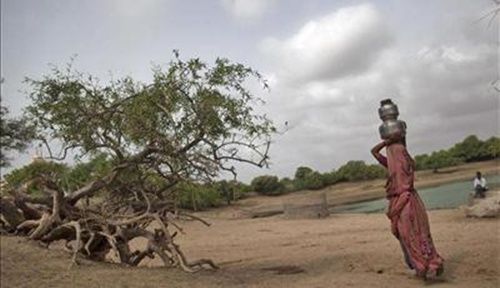Since 2000, India has had three serious droughts. The World Bank has estimated that the 2012 drought reduced the country's gross domestic product by half a percentage point, even though it was not extensive, say Asit K Biswas and Cecilia Tortajada.

Acording to the Food and Agriculture Organisation (FAO), droughts are the world's costliest natural disasters, inflicting $6-8 billion of annual losses.
Because of their extent, magnitude and frequency, their effects are felt by more people in the world than any other type of natural disaster.
The FAO further estimates that some 11 million people have died because of droughts since 1900, and over two billion people have suffered them.
Another United Nation's institution, the Economic and Social Commission for Asia and the Pacific, estimates that within the last three decades, in Asia only, some 1.3 billion people were affected, and the cost was over $53 billion.
Droughts have ravaged India from time immemorial.
They are different from other forms of natural disasters since its impacts are not visible immediately and are accumulative.
For a predominantly agrarian country like India, importance of droughts, which basically means the absence of good monsoon, has been well-known for millennia. In Mahabharata, Rishi Narada greeted King Yudhisthira with "I hope your realm has reservoirs that are large and full of water, located in different parts of the land, so that agriculture does not depend on the caprice of the Rain God."
Rain gauges were invented in India by Kautilya around 320 B C. He used measured rainfalls as a proxy for prosperity and thus taxation.
Some 2,200 years later, Sir Guy Wilson noted in 1909 that the Indian budget "is largely a gamble on rain." A century later, in 2010, then Finance Minister Pranab Mukherjee, invoked the rain god, Indra, for a good monsoon, so that the growth trajectory could be maintained.
During the 19th and 20th centuries, India suffered 42 serious droughts, one every five years. The 1979 drought reduced grain production by 20 per cent. The 1987 drought affected production in 58.6 million hectares of land, which affected 285 million people.
Since 2000, India has had three serious droughts. The World Bank has estimated that the 2012 drought reduced the country's gross domestic product by half a percentage point, even though it was not extensive.
This year, the monsoon rain is expected to be the weakest since 2009.
The India Meteorological Department estimates that rainfall has been 17 per cent below normal so far this season.
The planting of crops such as rice, soya bean and lentils has been delayed. Nearly 90 per cent of India received below normal rainfall in June.
Minister of Earth Sciences, Jitendra Singh, said early this month that rainfall is likely to be 24 per cent less in the main grain and sugarcane growing areas of north-west and 11 per cent less in the central region, the main soya bean producing area.
Not surprisingly, because of these developments, the Reserve Bank of India left interest rates at eight per cent for the third straight meeting in early August, citing upward pressure to inflation.
In 2009, when rainfall was 22 per cent below normal, inflation doubled because of food shortages.
India will have to live with droughts in the future.

The current policy continues to manage droughts as part of an emergency and disaster relief process, which is effective over the short-term, but not over the long-term.
A negative impact of the current policy is that farmers and agribusiness are taking unnecessary risks with full confidence that the government will bail them out during droughts.
Also, focus on technical solutions addresses primarily the symptoms but not the disease.
As the industrialisation and mechanisation of agriculture continues to advance, new and proactive policies are essential, which will diversify production risks and will consider new and more effective drought management strategies.
Strategies must include significant improvements in water use efficiencies in agriculture water use, which now accounts for nearly 90 per cent of the country's water consumption.
India has enough knowledge and resources to reduce water use for agriculture by about 30 to 40 per cent within a decade.
Also, in drought-prone areas, many water-intensive crops are still being planted that are not suitable for water-stress conditions, primarily because the government continues to assume most droughts risks.
Groundwater withdrawal accelerates significantly in drought years. In northern states of highest agricultural production, groundwater levels are declining by one metre every three years. In drought years, the situation worsens.
Over the longer-term, India also needs to give more emphasis to plant breeding and genetic modifications to develop a new variety of crops that are drought-resistant and salt-tolerant.
Researchers in Egypt have shown that by transferring a single gene from barley to wheat, water requirements could be reduced by over 80 per cent. India needs to accelerate research on genetically modified crops and plant breeding.

The country needs better water management practices in all sectors. The current practices are at least 30 years behind time.
During drought years, because of decades of poor water management, the overall impacts increase significantly.
The country needs a paradigm shift in water management policies, especially during drought years.
This should include emphasis on drought forecasting, preparedness and mitigation, as well as more effective short-term emergency and relief measures.
(Cecilia Tortajada is Senior Research Fellow and Asit K. Biswas is Distinguished Visiting Professor at Lee Kuan Yew School of Public Policy in Singapore.
Both are co-founders of the Third World Centre for Water Management in Mexico.)
Photographs: Amit Dave/Ahmad Masood Reuters











